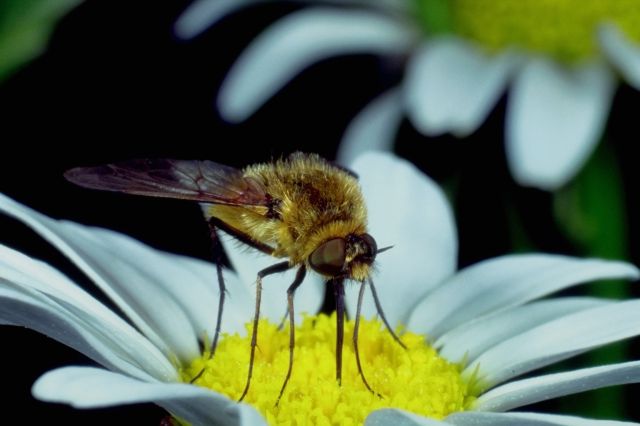

The following report of research, suggesting that bees possess the concepts of sameness and difference, is taken from the San Francisco Chronicle (article by science writer K. Davidson, Thursday April 19, 2001):
Bees brighter than we knew, study finds
They pass cognitive tests usually given apes, people
Our pollen-hunting friends possess "higher cognitive functions," judging by cunning experiments in which the creatures learned to compare and distinguish different colors and patterns, according to today's issue of Nature.
In what an outside expert praises as "an exciting discovery," the French researcher Martin Giurfa and four colleagues showed that honeybees -- that's Apis mellifera to bee fanciers -- excel at cognitive tests normally performed by lab primates and human volunteers.
To demonstrate this, Giurfa and his team exposed bees to a simple Y-shaped maze. The entrance to the maze was marked with a particular symbol -- say, the color yellow.
As the Nature article shows, bees also can engage in abstract thought. The creatures can "master abstract inter-relationships," specifically the cognitive concepts of "sameness" and "difference," Giurfa and his team report. Hence, "higher cognitive functions are not a privilege of vertebrates," that is, creatures with backbones and much more complex nervous systems.
A bee flying through the entrance encountered a branching pathway. One branch was marked with the color yellow, another with the color blue. Bees that pursued the yellow-marked path discovered at its end a vial rich in sugar.
Bees that took the blue path got no sugar.
Normally, bees would have been just as likely to fly one way as another. But via Giurfa's experiment, the bees learned that sugar lay at the end of the route marked with the same symbol as that marking the outside entrance. In other words, "same" equals "sugar."
The bees demonstrated an ability to recognize "sameness" and "difference" - fundamental skills on any test of cognitive abilities.
In a second experiment, the bees showed they could apply the concepts of "sameness" and "difference" beyond what they had learned in the first experiment.
In subsequent experiments, the opening to the maze was marked by a different symbol -- such as vertical dark lines. In that case, on entering the maze the bees re-encountered the two pathways, which this time were marked not with colors but, rather, with lines -- vertical lines on one path, horizontal lines on the other.
Had the bees remembered the lesson of the first experiment, namely that "same" equals "sugar"? They had. In the second experiment, more than 70 percent of the bees promptly flew down the path marked by vertical dark lines, the same symbol as that above the entrance.
My proposals for testing the boundaries of bees' concepts of "sameness" and "difference"
In my thesis, I discussed the question of whether bees can (i) generalise their concepts of sameness and difference across different senses and (ii) form a multi-modal concept of sameness. I propose the following two tests:
(ii) Can they form a multi-modal concept of sameness, such that if they enter a maze marked with a visual cue and an odour, and then encounter a fork with multiple branches, they fly down the one with the same visual cue and odour?
...[R]ecent research has found that bees are capable of cognitive performances that were previously thought to occur only in some vertebrate species. For example, honeybees can interpolate visual information, exhibit associative recall, categorize visual information and learn contextual information. Here we show that honeybees can form "sameness" and "difference" concepts. They learn to solve delayed-matching-to-sample and delayed-non-matching to sample discriminations and transfer the learned rules to novel stimuli of the same or a different sensory modality. Thus, bees can, not only learn specific objects and their physical parameters, but also master abstract interrelationships, such as "sameness" and "difference".
Bees are famously busy -- but they're also pretty brainy.
(i) After being trained to enter a Y-shaped maze whose entrance is marked by a visual cue, and then fly down the arm of the maze marked with the same visual cue, can they generalise across modalities, and apply the "sameness" rule to a maze whose entrance is marked by a neutral odour, and which has branching arms, one of which has the same odour as the entrance?